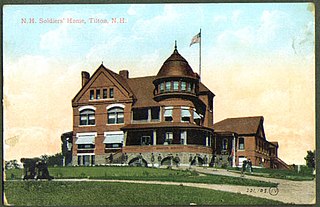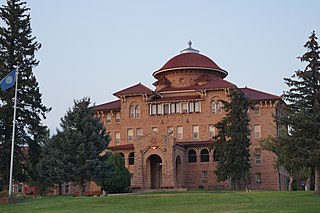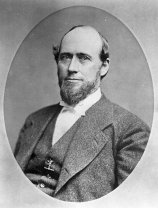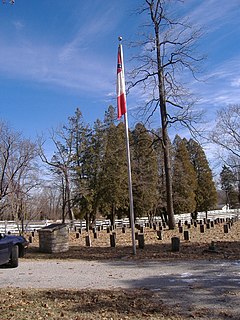Related Research Articles

The United States Department of Veterans Affairs (VA) is a Cabinet-level executive branch department of the federal government charged with providing life-long healthcare services to eligible military veterans at the 170 VA medical centers and outpatient clinics located throughout the country. Non-healthcare benefits include disability compensation, vocational rehabilitation, education assistance, home loans, and life insurance. The VA also provides burial and memorial benefits to eligible veterans and family members at 135 national cemeteries.

Hays is a city in and the county seat of Ellis County, Kansas, United States. The largest city in northwestern Kansas, it is the economic and cultural center of the region. As of the 2020 census, the population of the city was 21,116. It is also a college town, home to Fort Hays State University.

Dodge City is the county seat of Ford County, Kansas, United States, named after nearby Fort Dodge. As of the 2020 census, the population of the city was 27,788. The city is famous in American culture for its history as a wild frontier town of the Old West.

The United States National Cemetery System is a system of 172 cemeteries in the United States and its territories. The authority to create military burial places came during the American Civil War, in an act passed by the U.S. Congress on July 17, 1862. By the end of 1862, 14 national cemeteries had been established. A national cemetery is generally a military cemetery containing the graves of U.S. military personnel, veterans and their spouses, but not exclusively so. The best known national cemetery is Arlington National Cemetery in Arlington County, Virginia, adjacent to Washington, D.C. Some national cemeteries, especially Arlington, have graves of civilian leaders and other national figures. Some national cemeteries also contain sections for Confederate soldiers. In addition to national cemeteries, there are also state veteran cemeteries.

Moses Henry Dodge was a Democratic member to the U.S. House of Representatives and U.S. Senate, Territorial Governor of Wisconsin and a veteran of the Black Hawk War. His son, Augustus C. Dodge, served as a U.S. Senator from Iowa; the two were the first and so far the only father-son pair to serve concurrently in the Senate, which they did from 1848 to 1855.

An old soldiers' home is a military veterans' retirement home, nursing home, or hospital, or sometimes an institution for the care of the widows and orphans of a nation's soldiers, sailors, and marines, etc.

The National Asylum for Disabled Volunteer Soldiers was established on March 3, 1865, in the United States by Congress to provide care for volunteer soldiers who had been disabled through loss of limb, wounds, disease, or injury during service in the Union forces in the American Civil War. Initially, the Asylum, later called the Home, was planned to have three branches: in the Northeast, in the central area north of the Ohio River, and in what was then considered the Northwest, the present upper Midwest.

Fort Leavenworth National Cemetery is a United States National Cemetery located on Fort Leavenworth, a United States Army installation north of Leavenworth, Kansas. It was officially established in 1862, but was used as a burial ground as early as 1844, and was one of the twelve original United States National Cemeteries designated by Abraham Lincoln. The cemetery is the resting place of eight Medal of Honor recipients, but most are the less famous casualties of war. It was named for Brigadier General Henry Leavenworth, who was re-interred there in 1902 from Woodland Cemetery in Delhi, New York. Administered by the United States Department of Veterans Affairs, it occupies approximately 36.1 acres (14.6 ha) and was site to over 22,00 interments, as of 2020. It is maintained by Leavenworth National Cemetery.

James Madison Harvey was a United States senator from Kansas and fifth Governor of Kansas.

The Armed Forces Retirement Home refers to one of two facilities, one in Gulfport, Mississippi, the other in Washington, D.C., that house veterans and active duty members of the United States Armed Forces.
Fort Zarah was a fort in Barton County, Kansas, northeast of present-day Great Bend, Kansas, that was used from 1864 to 1869.

Pawnee is a ghost town in Geary County, Kansas, United States, which briefly served as the first official capital of the Kansas Territory in 1855. Pawnee was the territorial capital for exactly five days – the legislature met there from July 2 to July 6 – before legislators voted to move the capital to Shawnee Mission, which is located in present-day Fairway. It may be the shortest-lived capital of any U.S. state or territory.

Zophar Mack Mansur was an American Civil War veteran, lawyer, banker, and politician who served as the 40th lieutenant governor of Vermont.

Thomas Carney was the second Governor of Kansas.

John Whitnah Leedy was the 14th Governor of Kansas, serving 1896 to 1898. He later was active in politics in Alaska and Alberta, Canada.

Pewee Valley Confederate Cemetery is one mile from the site of the old Kentucky Confederate Home. The cemetery is not only on the National Register of Historic Places, but an individual monument within it, the Confederate Memorial in Pewee Valley, is separately on it as part of the Civil War Monuments of Kentucky MPS. It is the only cemetery for Confederate veterans, 313 in total, that is an official state burying ground in Kentucky.

The site of Fort Dodge in the U.S. state of Kansas was originally an old campground for wagons traveling along the Santa Fe Trail, just west of the western junction of the Wet and Dry Routes and near the middle or Cimarron Cutoff. On March 23, 1865, Major General Grenville M. Dodge, who commanded the 11th and 16th Kansas Cavalry Regiments, wrote to Colonel James Hobart Ford to propose establishing a new military post west of Fort Larned. On orders of Col. Ford, Captain Henry Pearce, with Company C, Eleventh Cavalry Regiment, and Company F, Second U.S. Volunteer Infantry, from Fort Larned, occupied and established Fort Dodge on April 10, 1865.
In 1864 Gen. Samuel R. Curtis established a military camp at the Fort Riley-Fort Larned Road crossing of the Smokey Hill River in what is now Ellsworth County, Kans.
Osawatomie State Hospital is a psychiatric hospital established in 1863 and opened in 1866 in Osawatomie, Kansas. It has been named "Kansas Insane Asylum" and the "State Insane Asylum" but was officially changed to its present name in 1901.

The Soldiers' Home in Holyoke is a full-service veterans center and hospital located in Holyoke, Massachusetts, which maintains 247 beds in its main nursing facility, and a separate domiciliary care building with 30 full-time residents. The facility provides long-term care and outpatient medical services, as well as dental and social services, and programming and events for veterans. Operated by the Massachusetts Department of Veterans' Services, it is inspected annually by both the state and the United States Department of Veterans' Affairs.
References
- ↑ "Fort Dodge Dispute Settled by Records: Authentic History Received from Washington: Established as Military Post in 1864, Became Fort in 1865, Soldiers' Home in 1886," Topeka Daily Capital, June 28, 1931, p. 7B; "Kansas Soldiers' Home: Fort Dodge, Kansas" (N.p.: 1975), pp. 2, 7-8; Dr. V. V. Andamson, "The Origin of the Fort Dodge Soldiers' Home," Dodge City Daily Globe , October 15, 1917, p. 6; Frank W. Blackmar, ed., Kansas: A Cyclopedia of State History (Chicago: StandardPub. Co., 1912), Vol. I, p. 659 "KANSAS: Cyclopedia - 1912". Archived from the original on 2009-12-21. Retrieved 2010-01-26. .
- ↑ Kenneth W. Felts, "4th of July 1890: Fort Dodge, Kansas Soldiers Home," www.skyways.org/orgs/fordco/july.html ; Andamson, p. 6; Blackmar, p. 659."Fort Dodge, Kansas," http://www.santafetrailresearch.com/research/fort-dodge.html .
- ↑ "Fort Dodge, Kansas."
- ↑ Felts, http://www.skyways.org/orgs/fordco/july.html
- ↑ "Fort Dodge,Kansas," www.santafetrailresearch.com/research/fort-dodge.html ; Kansas Commission on Veterans' Affairs website, www.kcva.org/cp/fort_dodge.shtml . Kansas Soldiers' Home, Fort Dodge, Kansas, Admission Handbook, p. 2, Kansas Commission on Veterans' Affairs website.
- ↑ Kansas Commission on Veterans' Affairs website; Kansas Soldiers' Home . . . Handbook, p. 2.
- ↑ "Best Nursing Homes - USNews.com https://www.usnews.com/listings/nursing-homes/ks/175513/health ; Kansas Soldiers' Home . . . Handbook, p. 3.
- ↑ "Jim Kelley, Dodge Pioneer, Is Dead", Dodge City Daily Globe, September 10, 1912, p. 1